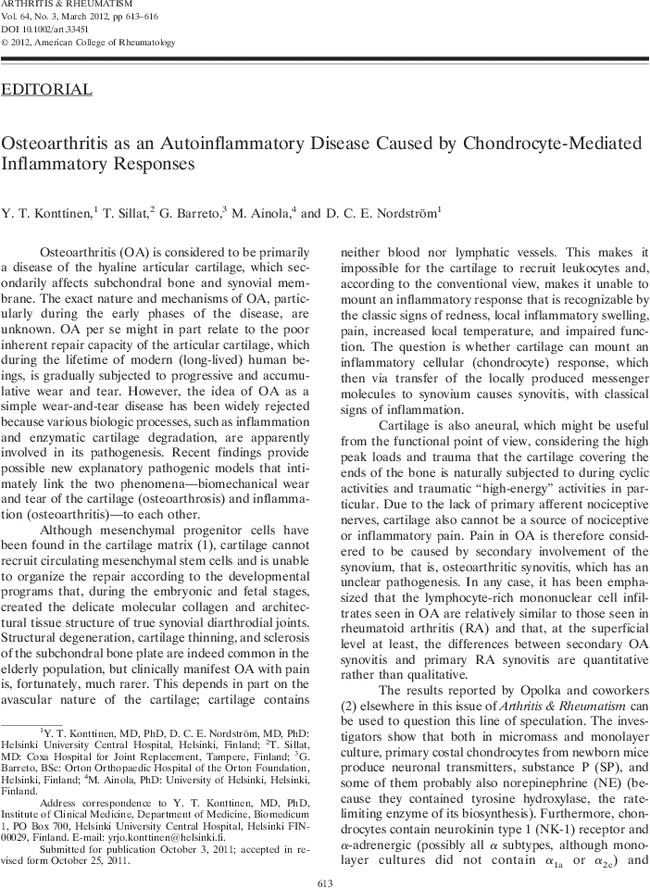Special Articles
Editorial: Osteoarthritis as an autoinflammatory disease caused by chondrocyte-mediated inflammatory responses
Y. T. Konttinen,
T. Sillat,
G. Barreto,
M. Ainola, D. C. E. Nordström,
Corresponding Author
Y. T. Konttinen
Helsinki University Central Hospital, Helsinki, Finland
Institute of Clinical Medicine, Department of Medicine, Biomedicum 1, PO Box 700, Helsinki University Central Hospital, Helsinki FIN-00029, FinlandSearch for more papers by this authorT. Sillat
Coxa Hospital for Joint Replacement, Tampere, Finland
Search for more papers by this authorG. Barreto
Orton Orthopaedic Hospital of the Orton Foundation, Helsinki, Finland
Search for more papers by this authorD. C. E. Nordström
Helsinki University Central Hospital, Helsinki, Finland
Search for more papers by this authorY. T. Konttinen,
T. Sillat,
G. Barreto,
M. Ainola, D. C. E. Nordström,
Corresponding Author
Y. T. Konttinen
Helsinki University Central Hospital, Helsinki, Finland
Institute of Clinical Medicine, Department of Medicine, Biomedicum 1, PO Box 700, Helsinki University Central Hospital, Helsinki FIN-00029, FinlandSearch for more papers by this authorT. Sillat
Coxa Hospital for Joint Replacement, Tampere, Finland
Search for more papers by this authorG. Barreto
Orton Orthopaedic Hospital of the Orton Foundation, Helsinki, Finland
Search for more papers by this authorD. C. E. Nordström
Helsinki University Central Hospital, Helsinki, Finland
Search for more papers by this author
REFERENCES
- 1 Alsalameh S, Amin R, Gemba T, Lotz M. Identification of mesenchymal progenitor cells in normal and osteoarthritic human articular cartilage. Arthritis Rheum 2004; 50: 1522–32.
- 2 Opolka A, Straub RH, Pasoldt A, Grifka J, Grassel S. Substance P and norepinephrine modulate murine chondrocyte proliferation and apoptosis. Arthritis Rheum 2012; 64: 729–39.
- 3 Richter F, Natura G, Loeser S, Schmidt K, Viisanen H, Schaible HG. Tumor necrosis factor causes persistent sensitization of joint nociceptors for mechanical stimuli in rats. Arthritis Rheum 2010; 62: 3806–14.
- 4 Konttinen YT, Kemppinen P, Segerberg M, Hukkanen M, Rees R, Santavirta S, et al. Peripheral and spinal neural mechanisms in arthritis, with particular reference to treatment of inflammation and pain [review]. Arthritis Rheum 1994; 37: 965–82.
- 5 Kim HA, Cho ML, Choi HY, Yoon CS, Jhun JY, Oh HJ, et al. The catabolic pathway mediated by Toll-like receptors in human osteoarthritic chondrocytes. Arthritis Rheum 2006; 54: 2152–63.
- 6 Pevsner-Fischer M, Morad V, Cohen-Sfady M, Rousso-Noori L, Zanin-Zhorov A, Cohen S, et al. Toll-like receptors and their ligands control mesenchymal stem cell functions. Blood 2007; 109: 1422–32.
- 7 Heinola T, Kouri VP, Clarijs P, Ciferska H, Sukura A, Salo J, et al. High mobility group box-1 (HMGB-1) in osteoarthritic cartilage. Clin Exp Rheumatol 2010; 28: 511–8.
- 8 Chang ZL. Important aspects of Toll-like receptors, ligands and their signaling pathways. Inflamm Res 2010; 59: 791–808.
- 9 Erridge C. Endogenous ligands of TLR2 and TLR4: agonists or assistants? J Leukoc Biol 2010; 87: 989–99.
- 10 Hodgkinson CP, Ye S. Toll-like receptors, their ligands, and atherosclerosis. ScientificWorldJournal 2011; 11: 437–53.




